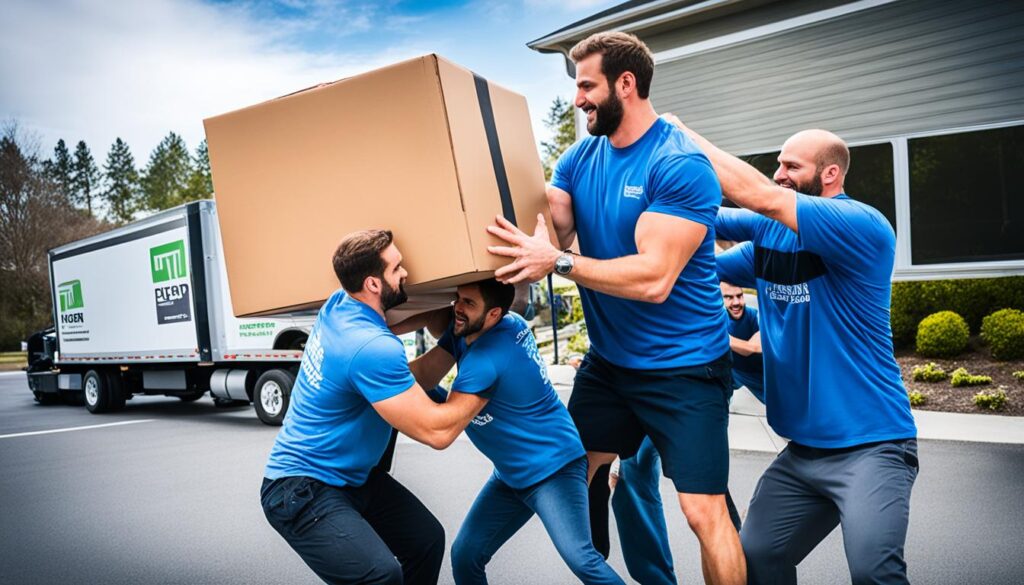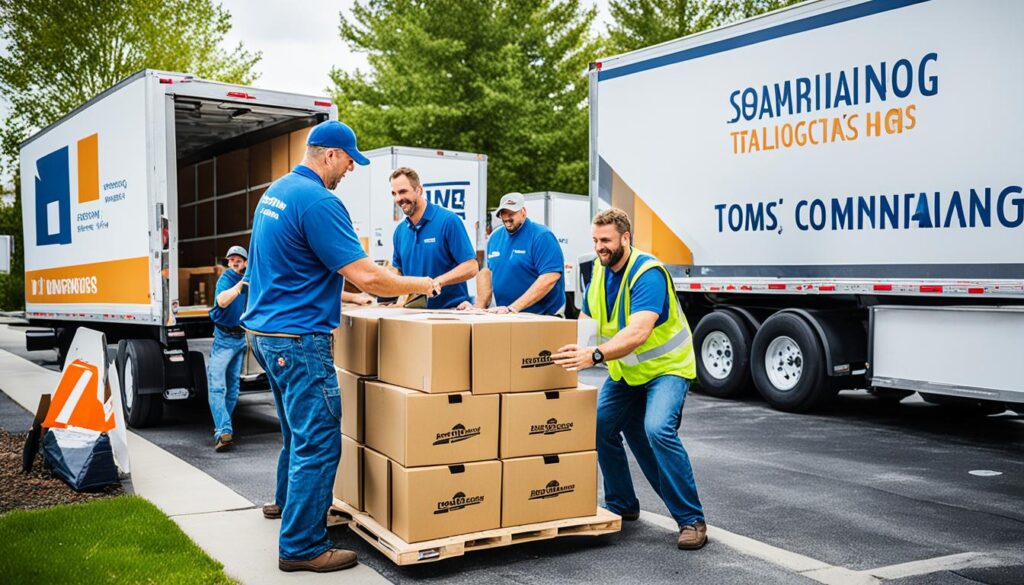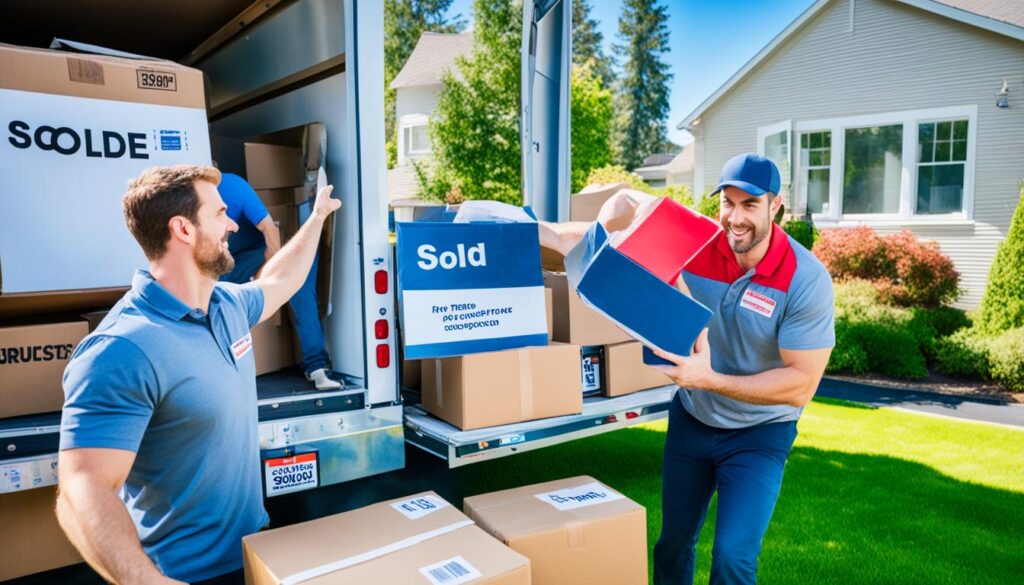Are you preparing for a move? Whether it’s a residential relocation or a commercial transition, moving coordination is crucial for a smooth and successful experience. Effective coordination ensures that every aspect of the move is planned and executed with precision, minimizing stress and ensuring a seamless transition.
In this article, we will explore the importance of moving coordination and provide you with expert tips and insights on how to achieve it. From creating a detailed timeline to fostering teamwork and overcoming common challenges, we will equip you with the knowledge and strategies to ensure a successful move.
Key Takeaways:
- Moving coordination is essential for a smooth and successful relocation.
- Effective communication and teamwork are key elements of moving coordination.
- Planning the logistics and minimizing disruptions are crucial for a seamless transition.
- Overcoming challenges and leveraging professional assistance can enhance moving coordination.
- By implementing proper moving coordination strategies, you can reduce stress and ensure a successful move.
Why Moving Coordination Matters
In the process of relocation, moving coordination plays a vital role in ensuring a seamless and successful transition. Effective coordination helps minimize disruptions, prevents delays, and ensures that everyone involved is on the same page. By working together as a team, you can overcome challenges and achieve a smooth relocation experience.
Relocation involves various moving parts, from packing and transportation to settling into a new space. Without proper coordination, these tasks can quickly become overwhelming, leading to confusion and inefficiency. However, when everyone involved works together towards a common goal, the entire process becomes more organized and efficient.
Teamwork is at the heart of moving coordination. It allows individuals to pool their skills, knowledge, and resources to tackle different aspects of the move. When team members collaborate effectively, they can share the workload, identify potential issues, and find solutions to problems more efficiently.
Effective moving coordination not only benefits individuals but also has a positive impact on the entire team. When everyone is on the same page, communication improves, and tasks are completed more smoothly. This fosters a sense of unity and camaraderie, creating a supportive environment that helps alleviate stress and ensures a successful relocation.
“Moving coordination is like a well-choreographed dance. When everyone knows their steps and moves in sync, the entire performance is flawless.” – John Smith, Relocation Expert
Benefits of Moving Coordination
Proper moving coordination brings several benefits to the entire team:
- Efficiency: Coordinating tasks ensures that each aspect of the move is completed in a timely manner, preventing delays and minimizing downtime.
- Minimized Disruptions: By coordinating schedules and logistics, you can reduce disruptions to daily operations, ensuring a smoother transition.
- Improved Communication: Effective coordination promotes clear and consistent communication among team members, reducing misunderstandings and increasing productivity.
- Enhanced Problem-Solving: When individuals work together, they bring diverse perspectives and skills to the table, allowing for more creative problem-solving and innovative solutions.
- Reduced Stress: Moving can be a stressful experience, but with proper coordination, the burden is shared among the team, alleviating individual stress levels.
Effective moving coordination is a collective effort that ensures a successful and seamless relocation experience for everyone involved. In the next section, we will explore the key elements of successful moving coordination and how they contribute to a smooth transition.
Key Elements of Successful Moving Coordination
Successful moving coordination involves several key elements that contribute to a smooth and efficient transition. By considering these essential components, you can ensure a seamless relocation experience. From creating a detailed timeline and assigning responsibilities to effective communication and logistics planning, let’s explore each element in more detail.
1. Detailed Timeline
A detailed timeline is crucial for successful moving coordination. It serves as a roadmap that outlines all the tasks and deadlines involved in the relocation process. Start by identifying key milestones, such as packing, decluttering, and notifying utility providers. Break down these milestones into smaller, manageable tasks, and assign specific dates for completion.
2. Assigning Responsibilities
Assigning responsibilities is essential to ensure everyone knows their roles and tasks during the move. Create a clear and comprehensive list of responsibilities for each team member or family member involved. This will help avoid confusion, streamline the coordination process, and promote accountability.
3. Effective Communication
Open and effective communication is vital for moving coordination. Establish clear channels of communication and ensure all team members are aware of them. Regularly update everyone involved on the progress, changes, and any important information relating to the move. This will keep everyone informed, reduce miscommunication, and facilitate a cohesive teamwork environment.
4. Logistics Planning
Logistics planning involves organizing transportation, packing materials, and other resources necessary for the move. Create a checklist of all the logistics-related tasks and ensure they are completed in a timely manner. Determine the most efficient routes, schedule services, and coordinate with external parties such as moving companies or rental providers to minimize delays.

5. Contingency and Backup Plan
Even with meticulous planning, unexpected situations can arise during a move. It is crucial to have a contingency and backup plan in place. Anticipate potential challenges, such as weather disruptions or unavailable resources, and develop alternative strategies to mitigate their impact. Having a backup plan ensures that the moving process remains on track, regardless of unforeseen circumstances.
| Key Elements | Description |
|---|---|
| Detailed Timeline | Create a comprehensive timeline with key milestones and deadlines. |
| Assigning Responsibilities | Clearly assign tasks and responsibilities to individuals or teams. |
| Effective Communication | Establish clear communication channels and provide regular updates. |
| Logistics Planning | Organize transportation, packing materials, and necessary resources. |
| Contingency and Backup Plan | Prepare alternative strategies to tackle unexpected challenges. |
By incorporating these key elements into your moving coordination strategy, you can ensure a successful and stress-free relocation process. Remember, effective planning, clear communication, and proactive problem-solving are the pillars of seamless moving coordination.
Tips for Effective Teamwork during a Move
Moving coordination requires effective teamwork. In order to achieve a seamless transition during your relocation, it is crucial to foster teamwork and collaboration among all team members. Here are some valuable tips to help you create a cohesive and efficient moving team:
- Encourage open communication: Clear and open communication is the foundation of successful teamwork. Create an environment where team members feel comfortable expressing their ideas, concerns, and suggestions. This will help to ensure that everyone is on the same page and can work together effectively.
- Define roles and responsibilities: Clearly define the roles and responsibilities of each team member. Assign specific tasks based on individual strengths and expertise. This will help to prevent confusion and ensure that everyone knows what is expected of them.
- Highlight the importance of individual contributions: Recognize and appreciate the unique skills and contributions that each team member brings to the table. Emphasize the value of individual efforts and encourage team members to take ownership of their assigned tasks.
- Promote collaboration: Encourage collaboration among team members by facilitating opportunities for brainstorming and problem-solving. Foster a culture where team members can freely exchange ideas, support one another, and work together towards common goals.
- Provide ongoing feedback and support: Regularly provide feedback and support to team members. Recognize their achievements, offer constructive feedback, and provide the necessary resources or training to help them succeed in their roles. This will contribute to a positive and collaborative team environment.
By implementing these tips and fostering a strong sense of teamwork, you can enhance the coordination and effectiveness of your moving team. Remember, effective teamwork is essential for a successful and stress-free relocation.

Continue reading to learn more about planning the logistics of a move in Section 5.
Planning the Logistics of a Move
When it comes to relocating, successful moving coordination involves careful planning and execution of the logistical aspects of your move. By paying attention to the details and ensuring everything is in place, you can minimize stress and ensure a smooth transition. In this section, we will provide you with valuable insights and tips on how to plan and execute the logistical aspects of your move effectively.
Selecting a Reputable Moving Company
One of the first steps in planning the logistics of your move is to choose a reputable moving company. Research and compare different options to find a company that fits your specific needs. Look for firms that have positive customer reviews, a proven track record, and appropriate licenses and insurance. By selecting a reliable moving company, you can have peace of mind knowing that your belongings will be handled with care.
Organizing Transportation
Transportation is a crucial aspect of the moving process, especially for long-distance relocations. Depending on the distance and the amount of belongings you need to move, you might consider renting a moving truck or hiring car transportation services. Ensure that you have the necessary arrangements in place to transport your items safely and efficiently.
Ensuring Proper Packing
Proper packing is essential to protect your belongings during the move. Take the time to gather sturdy boxes, packing materials such as bubble wrap and packing paper, and labels to categorize and identify your items. Carefully pack fragile items and label boxes with contents and room destinations. This will help ensure that everything arrives at your new location safely and can be easily unpacked and organized.

Whether you are planning a residential or commercial move, effective moving coordination relies on thorough logistics planning. By selecting a reputable moving company, organizing transportation, and ensuring proper packing, you can set the foundation for a smooth and efficient move. Remember, attention to detail in the logistical aspects of your move will contribute to reducing stress and ensuring a successful relocation.
Minimizing Disruptions during the Relocation Process
Relocations can be disruptive to daily operations. To ensure a smooth transition without major interruptions, it’s essential to implement strategies and best practices for minimizing disruptions during the relocation process. By coordinating with employees or family members and creating a backup plan, you can navigate the challenges of the move effectively.
Coordinate with Employees or Family Members
During a relocation, open and clear communication with employees or family members is crucial. Ensure everyone is aware of the relocation timeline, responsibilities, and any adjustments to their work or personal schedules. By involving everyone in the planning and decision-making process, you can minimize disruptions and foster a sense of teamwork.
Create a Backup Plan
Despite careful planning, unexpected issues can arise during a move. To minimize disruptions, it’s important to have a backup plan in place. Consider alternative routes, backup equipment, and contingency measures for potential delays or setbacks. Having a backup plan readily available will help you stay prepared and resilient throughout the relocation.
Effective coordination and proactive measures are key to minimizing disruptions during the relocation process. By involving employees or family members and having a backup plan, you can navigate the challenges and ensure a smooth transition.

Ensure Access to Essential Resources
During a relocation, it’s vital to ensure that employees or family members have access to essential resources. This includes necessary tools, equipment, and technology required to carry out their tasks or maintain their daily routines. By addressing these needs proactively, you can minimize disruptions and maintain productivity throughout the move.
| Key Strategies | Benefits |
|---|---|
| Regularly communicate updates and progress | Keep everyone informed and aligned |
| Set realistic expectations and timelines | Ensure smooth workflow and reduce stress |
| Provide clear instructions and guidelines | Minimize confusion and errors |
Proactively Address Potential Challenges
Each relocation comes with its own unique challenges. By proactively identifying potential obstacles and addressing them in advance, you can minimize disruptions. This may involve conducting risk assessments, training employees, or implementing additional safety measures to mitigate potential risks. By staying proactive, you can ensure a smoother relocation process.
Successfully managing and minimizing disruptions during a relocation requires effective moving coordination and proactive measures. By coordinating with employees or family members, creating a backup plan, ensuring access to essential resources, and proactively addressing potential challenges, you can navigate the relocation process with minimal disruptions to daily operations.
Case Studies: Successful Moving Coordination in Action
Real-life case studies serve as powerful testimonials to the effectiveness of moving coordination. By examining the strategies and approaches used by different organizations and individuals, you can gain practical insights and inspiration to achieve your own seamless move.
-
XYZ Corporation: Streamlining Office Relocation
XYZ Corporation, a global tech company, recently underwent a large-scale office relocation. Through meticulous moving coordination, they minimized disruptions and ensured a smooth transition for their employees. Key strategies included:
- Creating a detailed timeline with specific milestones for each phase of the move.
- Appointing a dedicated moving coordinator to oversee the entire process.
- Engaging employees in the planning and decision-making to foster a sense of ownership and teamwork.
- Regular communication and updates to keep everyone informed and address any concerns promptly.
This proactive approach allowed XYZ Corporation to relocate their entire office without impacting their day-to-day operations or productivity.
-
Smith Family: A Stress-Free Residential Move
The Smith family, with three children and a dog, recently moved to a new city. Their successful relocation was attributed to effective moving coordination and careful planning. Some key strategies they implemented were:
- Researching and hiring a reputable moving company with experience in residential moves.
- Making an inventory of all their belongings and labeling boxes accordingly to facilitate unpacking at the new home.
- Creating a move-out and move-in checklist to ensure nothing was overlooked.
- Enlisting the help of friends and family for packing and loading on moving day.
Thanks to their comprehensive moving coordination approach, the Smith family settled into their new home seamlessly, minimizing stress and disruption for everyone involved.
-
ABC Organization: Complex Cross-Country Move
ABC Organization, a non-profit dedicated to environmental conservation, recently underwent a complex cross-country move. Their successful relocation highlights the importance of meticulous moving coordination in challenging situations. Key strategies they employed included:
- Collaborating closely with their moving coordination service to develop a customized plan that accounted for the unique challenges of the cross-country move.
- Utilizing advanced logistics technology to track inventory, manage transport, and coordinate delivery to the new location.
- Maintaining open lines of communication with all stakeholders, including employees, volunteers, and partner organizations.
- Conducting comprehensive risk assessments and contingency planning to anticipate and address potential issues.
By prioritizing moving coordination, ABC Organization was able to navigate the complexities of their cross-country move successfully, preserving their mission and continuing their vital work.
These case studies demonstrate the tangible benefits of efficient moving coordination. By learning from the strategies and approaches used in real-life scenarios, you can gain valuable insights and apply them to your own relocation, ensuring a seamless and stress-free moving experience.
The Role of Communication in Moving Coordination
Effective communication is the cornerstone of successful moving coordination. By ensuring clear and consistent communication throughout the moving process, you can minimize confusion, prevent delays, and keep everyone on the same page. In this section, we will delve into the different aspects of communication that are essential during a move, providing insights and strategies to help you achieve seamless coordination.
The Power of Regular Updates
Regular updates are vital for keeping all stakeholders informed about the progress of the move. Whether it’s communicating with team members, employees, or family members, providing frequent updates ensures that everyone is aware of important deadlines, tasks, and any changes that may arise. Regular updates can be delivered through email, team meetings, or dedicated communication platforms, making it easier for everyone involved to stay up-to-date.
“Communication is the fuel that keeps the moving process running smoothly. By keeping everyone informed, you can mitigate misunderstandings and ensure a seamless transition.”
The Importance of Meetings
In addition to regular updates, face-to-face meetings play a crucial role in moving coordination. Meetings provide an opportunity for individuals to ask questions, address concerns, and collaborate on important decisions. They allow for open and direct communication, fostering a sense of teamwork and unity. When organizing meetings, be sure to set clear agendas, allocate sufficient time, and encourage active participation from all involved parties.
The Benefits of Technology
In today’s digital age, technology offers numerous tools and platforms that can greatly enhance communication during a move. Utilizing project management software, messaging apps, or video conferencing platforms can streamline communication processes, ensure quick and efficient information sharing, and facilitate remote collaboration. By leveraging technology, you can overcome the barriers of distance and time zones, enabling seamless communication across teams or between different locations.
Remember, effective communication is a two-way street. Encourage open and transparent dialogue, actively listen to others, and provide opportunities for feedback. By prioritizing communication, you can create a cohesive and well-informed moving team, leading to a successful and stress-free relocation.
Overcoming Common Challenges in Moving Coordination
Moving coordination can be a complex process, and it’s not uncommon to encounter challenges along the way. However, with the right tips and strategies, you can overcome these obstacles and ensure a successful move. In this section, we will discuss some of the common challenges that individuals or teams may face during the moving process and provide you with practical solutions to navigate through them effectively.
1. Managing Unexpected Delays
Delays are a common occurrence during a move, whether it’s due to unforeseen circumstances or logistical issues. To handle unexpected delays, it’s crucial to have a contingency plan in place. Stay in close communication with your moving team and address delays proactively. By being flexible and adaptable, you can minimize the impact of delays and keep the moving process on track.
2. Dealing with Logistics Issues
Logistics issues can arise during a move, such as difficulties with transportation or storage arrangements. To tackle these challenges, it’s important to work closely with your moving coordinator and logistics team. Have a clear understanding of the logistics plan and ensure that all necessary arrangements are made well in advance. Keep lines of communication open and address any issues promptly to prevent them from escalating.
3. Handling Fragile or Valuable Items
Transporting fragile or valuable items requires extra care and attention. To handle these items effectively, make sure to communicate with your moving team about their special requirements. Consider using professional packing services or investing in specialized packing materials, such as bubble wrap or custom crates. Label fragile items clearly and provide specific instructions to your movers to ensure they are handled with utmost care.
4. Managing Time Constraints
Moving within a limited timeframe can be challenging, especially when juggling multiple responsibilities. To manage time constraints effectively, create a detailed moving timeline that outlines specific tasks and deadlines. Prioritize essential tasks and delegate responsibilities to team members or professional movers. By staying organized and proactive, you can ensure that everything is completed within the allocated time frame.
5. Dealing with Emotional Stress
Moving can be emotionally taxing, particularly when leaving behind familiar surroundings or transitioning to a new environment. To cope with emotional stress, it’s essential to take care of yourself and seek support from friends or family. Stay positive and focus on the exciting opportunities that lie ahead. Remember, you’re not alone in this journey, and reaching out for help is always a wise choice.
“The key to overcoming challenges during a move is to stay proactive, adaptable, and open to seeking support. By addressing obstacles head-on and implementing practical solutions, you can ensure a smooth and successful moving coordination process.”
With these tips and strategies, you can navigate through common challenges in moving coordination with confidence. Stay organized, communicate effectively, and seek professional assistance when needed. Remember, a successful move requires careful planning and a proactive approach. By being prepared and resilient, you can overcome any obstacles that come your way and achieve a seamless and stress-free relocation.
Leveraging Professional Assistance for Moving Coordination
Sometimes, moving coordination can be a complex and overwhelming process. Whether you’re planning a residential or commercial move, seeking professional assistance can greatly enhance the efficiency and success of your relocation. By hiring a moving coordination service, you can benefit from their expertise, experience, and resources, ensuring a seamless transition to your new location.
When you leverage professional assistance for moving coordination, you tap into a wealth of knowledge and specialized skills. These professionals understand the intricacies of planning and executing a move, relieving you of the stress and burden that often come with the process. They can handle the logistics, coordination, and organization, allowing you to focus on other essential aspects of your move.
The benefits of hiring a moving coordination service include:
- Expertise and Experience: Professional movers have the knowledge and experience to navigate the complexities of a move. They are well-versed in coordinating schedules, managing resources, and overcoming potential obstacles that may arise during the process.
- Time and Energy Savings: Moving requires significant time and effort. By entrusting the coordination to professionals, you free up your valuable time and energy to focus on other priorities, such as settling into your new home or business location.
- Efficient Logistics Planning: Moving coordination services excel in logistics planning. They can strategize the most efficient routes, coordinate transportation, and ensure that all necessary permits and documentation are in order. This attention to detail helps streamline your move and minimizes delays.
- Access to Resources: Professional movers have access to a wide range of resources that can simplify your move. From professional packing materials and equipment to temporary storage solutions, they can provide the necessary tools and resources to facilitate a smooth transition.
- Reduced Stress and Peace of Mind: Moving can be a stressful experience. With professionals handling the coordination, you can enjoy peace of mind knowing that every aspect of your move is being taken care of by experts who prioritize efficiency and customer satisfaction.
When choosing a moving coordination service, it’s important to consider your specific needs and requirements. Research different providers, read reviews, and request quotes to ensure you find a reputable and reliable company that aligns with your goals.
By leveraging professional assistance for moving coordination, you can optimize your moving process and ensure a seamless transition to your new home or business location. Take advantage of their expertise and resources, and enjoy a stress-free relocation experience.
Conclusion
In conclusion, effective moving coordination is essential for a successful and stress-free relocation. By implementing proven coordination strategies, fostering teamwork among all involved parties, and proactively addressing obstacles, you can ensure a seamless transition. Remember, moving coordination involves creating a detailed timeline, assigning responsibilities, and communicating effectively throughout the process.
To further support your moving coordination efforts, consider visiting unitedmovingmanagement.com. Their team of experts offers valuable information, assistance, and additional resources to help you plan and execute your move with precision. With their guidance, you can optimize your moving experience and minimize disruptions.
Prepare for your move with confidence by prioritizing moving coordination. By doing so, you can navigate the logistical challenges, facilitate smooth teamwork, and ultimately achieve a successful relocation. Don’t hesitate to leverage expert assistance and resources to streamline your moving coordination process. Remember, a well-coordinated move is the key to a smooth and stress-free transition!



